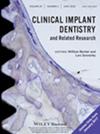A Multicenter Study of Factors Related to Early Implant Failures—Part 2: Patient Factors
Abstract
Background
Recent advancements in dental implant materials, designs, and surgery have increased their use, especially for challenging local conditions. As guidelines for individualized risk assessment are increasingly emphasized, implant treatment has become available to patients with diverse medical backgrounds. However, clinical research with large patient groups is needed to investigate the effects of patient-related factors associated with early implant failure.
Purpose
This paper investigates patient factors in two patient cohorts associated with early implant complications and failures.
Materials and Methods
The collected data were analyzed and presented in two studies. Both studies followed the same data collection methodology and compared cohorts treated in 2007 and 2017. The same patient-level dataset was analyzed, although the second study included additional analyses of diseases and allergies. Data were analyzed univariately (p < 0.20) to select variables for the multivariable logistic regression model (p < 0.05), with early implant failures and complications as dependent variables.
Results
In total, 1875 patients with 4670 implants were included. There were 74 (3.7%) dropouts, mainly due to lack of data. The 2007 cohort comprised 799 patients with 2473 implants, and the 2017 cohort comprised 1076 patients with 2287 implants. Differences were observed between the two cohorts for the number of implants per patient, exposed implant threads, and preoperative antibiotics. In the 2007 cohort, 23 (2.9%) patients had early implant failure. In the 2017 cohort, 40 (3.7%) had early implant failure (p > 0.30). Significantly more implants failed in the 2017 cohort (n = 56, 2.4%) than in the 2007 cohort (n = 26, 1.1%) (p < 0.001). Early complications were reported for 56 (7.0%) patients in 2007 and 145 (13.5%) patients in 2017 (p < 0.001). Three patient-related variables were associated with an increased risk of early failure—food allergy, exposed implant threads, and increased number of implants. Seven variables were related to an increased risk of complications: smoking, exposed threads, no preoperative antibiotics, number of implants, sinus perforations, food allergy, and metal allergy.
Conclusions
This study identified three factors associated with early implant failure and seven associated with early complications.

 求助内容:
求助内容: 应助结果提醒方式:
应助结果提醒方式:


